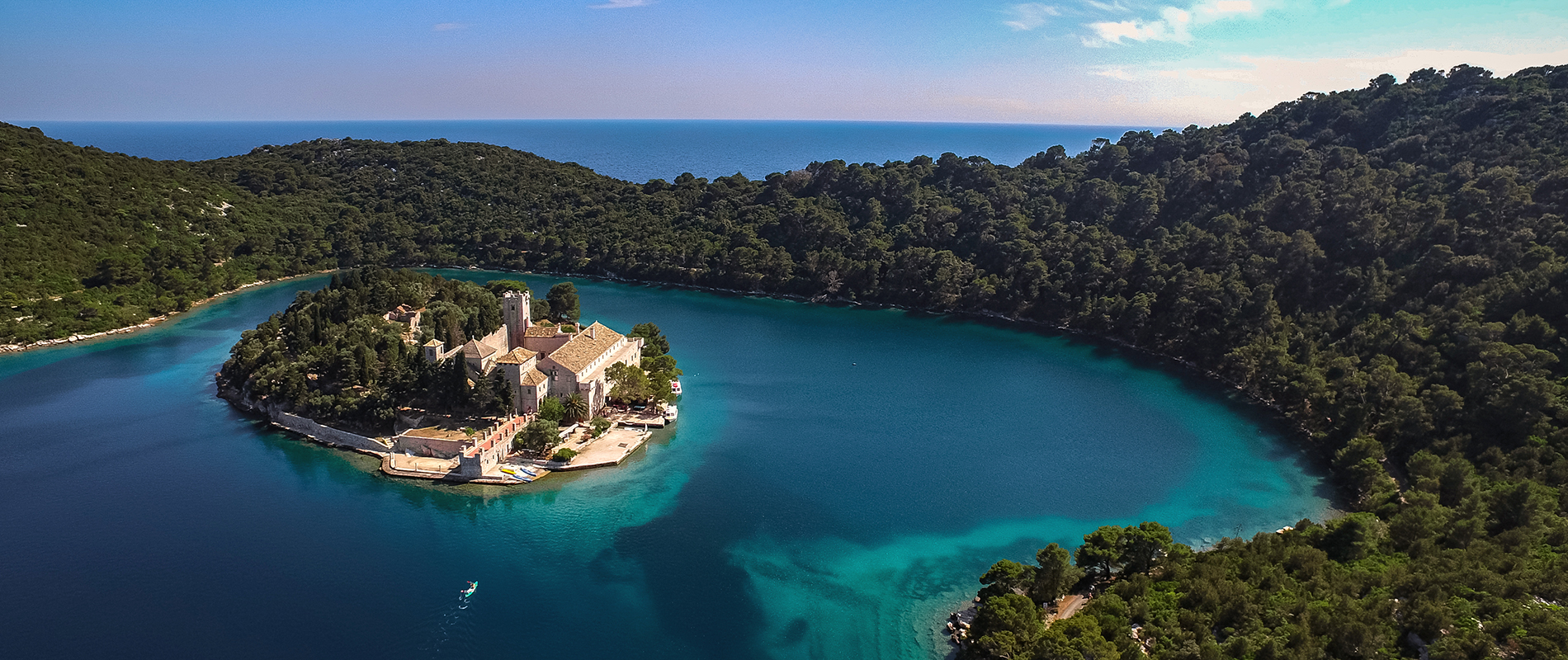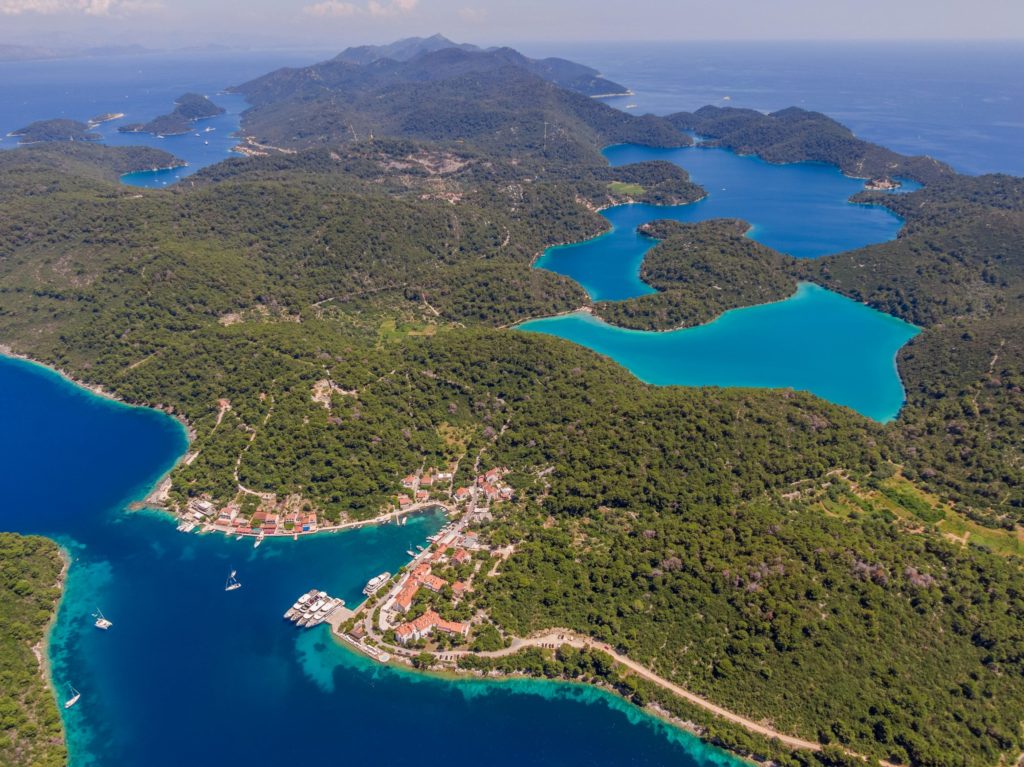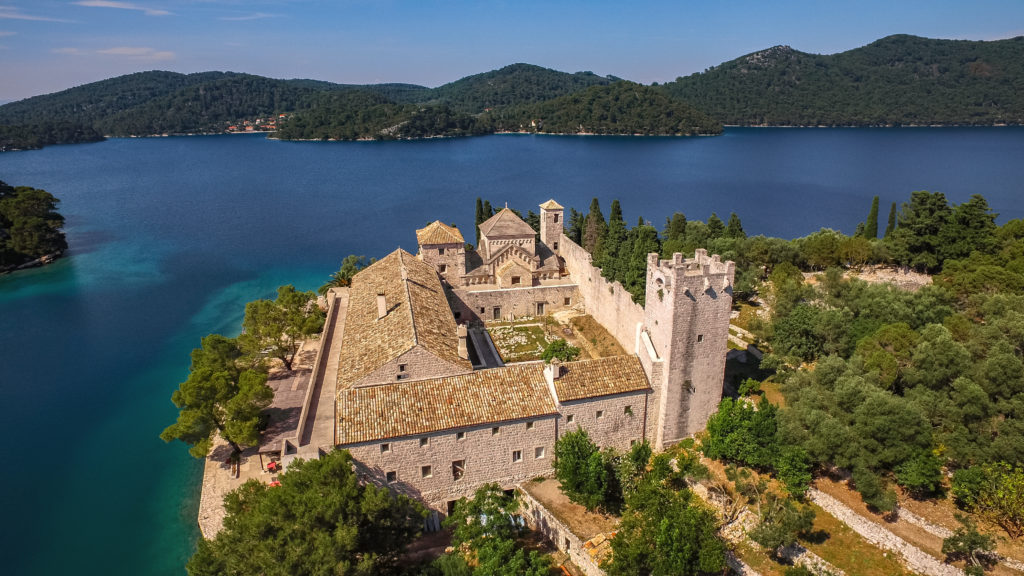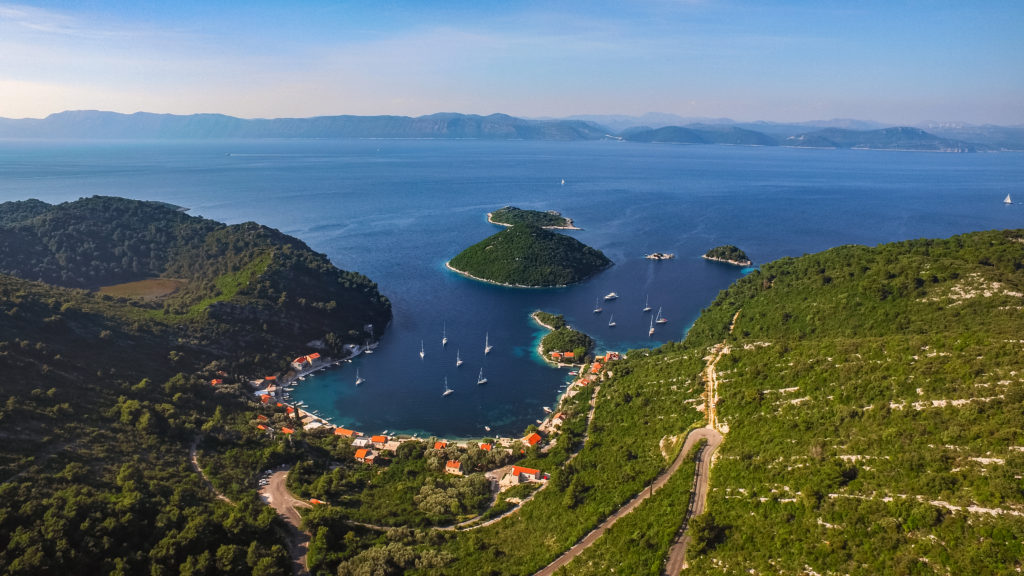
Mljet has long been one of Croatia’s most alluring islands; a verdant escape home to unspoiled nature, surprising history, rustic villages, picturesque beaches, and an air of tranquility unrivaled in Dalmatia. Yet somehow, this paradisical island remains largely off-the-beaten-path, sharing its charms only with the select few who venture to its shores. Tasteful Croatian Journeys invites you to delve deeper and discover Mljet’s secrets. Our Luxury Travel Designers have teamed up with local guide Michelle Ramonita Rodriguez Stražičić to explore Mljet’s unique legends, landscape, and culture. Together, we’ve put together this insider’s guide to what to see, do, and eat on Croatia’s greenest island.

Located in southern Dalmatia, between the coastal city of Dubrovnik and the island of Korčula, Mljet is the eighth largest Island in Croatia. It is nicknamed the “Green Island” due to the rich forest of Alepski Bor (Aleppo Pine) that extends from the sea’s bed to the highest point of the island’s surface. The Aleppo Pine was brought to Mljet from Alepa (Israel) before the time of Christ. The sap of the trees produces an aroma that is hypnotic, especially for first time visitors. It is a perfume which scents the air across the island.
Mljet’s main attraction is its National Park, which occupies the western part of the island. Here, visitors will find pristine natural beauty; untouched and protected. In the center of the park lie two enchanting cerulean saltwater lakes, Veliko Jezero and Malo Jezero (Big Lake and Small Lake). In the middle of the large lake lies the small Isle of Saint Mary, home to a 12th-century Benedictine monastery. Around the lakes, a blanket of thick forest stretches across the island interrupted only by olive groves, vineyards, and a handful of tranquil settlements.
Just off the coast, numerous shipwrecks and sunken Greek amphora hint at the island’s history. It is said to be Mljet, not Malta, which is the island “Melita” on which Saint Paul was shipwrecked. Similarly, it is Mljet, not Gozo (off the coast of Malta), which claims to be the mythical island of Ogygia described in Homer’s Odyssey. On the southern shore of the island, not far from Babino Polje, the island’s largest settlement, travelers can visit the limestone cave believed to be where Odysseus drifted after his shipwreck. There, he came across the beautiful nymph Calypso, who held him captive for seven years until his release was ordered by Zeus.

Set out for the western side of the island!
Independent travelers will find that Mljet is well connected to the mainland and other islands by public ferry and catamaran, making it an ideal single day excursion from both Dubrovnik and Korčula. Tasteful Croatian Journeys can also arrange private yacht and speedboat excursions for those seeking added comfort or flexibility.
The recommended ports of arrival for those planning to visit the national park are Pomena or Polače. During the summer, the small fishing village of Pomena functions as the island’s main city, with plenty of waterfront restaurants serving tasty local cuisine. It is also home to the island’s longest-established hotel, the Hotel Odisej, a comfortable three-star property which is part of the Adriatic Luxury Hotels collection.



Two miles away, the ancient trading port of Polače still holds remnants of the past, including the ruins of a Roman palace which date back to around the 5th century. Polače was known to be the safest port on the eastern side of the Adriatic, featuring a large bay sheltered by four small islets. Today the village is home to just over one hundred residents and has several restaurants and cafés.
Either village serves as an ideal starting point from which to explore Mljet National Park independently, by foot, bike, or kayak. Your Tasteful Croatian Journeys concierge is available to arrange bike, canoe, and kayak rentals. Together with Michelle, we can also arrange organized tours to explore the island’s cultural sights, such as the Odysseus Cave. As a resident of the island and professional in the hospitality industry, Michelle is able to put her local network and resources to work to facilitate the needs and wishes of our travelers.

When arriving, visitors must keep in mind that a third of the Island is protected territory and purchasing National Park entrance tickets is a mandatory step of the journey. As there is no official entrance to the park, tickets can be purchased from kiosks located in both Pomena and Polače, or in advance from the national park’s online web shop. The Kiosks also offer park maps and boat timetables.
The entrance tickets to the National Park include services for your entire stay on the Island, whether that is for one day or multiple days. Prices can be found above, listed in local currency (Kuna).


Once you’ve got your tickets, begin making your way toward the park’s main attraction, the saltwater lakes, Veliko and Malo Jezero (Big and Small Lake). There are lovely wooded trails leading to the lakes, and walking paths which encircle them. However, travelers with mobility issues should be aware of the moderate incline and occasional steps encountered.
Both lakes are home to many curiosities. The island is of volcanic origin, and the lakes were formed more than 10,000 years ago. Although the lakes link to each other through a small channel, and to the sea by a larger channel, they have a unique ecosystem all their own. In fact, a special species of jellyfish (part of the Aurelia genus) was found to be living in the lakes. The species is more than 24 million years old and cannot be found anywhere else in the world. However, travelers needn’t worry as it is harmless to humans. In addition, the Big Lake is home to the largest recorded bushy coral reef (Cladocora caespitosa) in the world. The bushy coral, also known as Mediterranean pillow coral, provides a place for fish and crab spawn to hide, protected from the current. Many species of sea life rely on the natural rotation of water in and out of the lakes. This, coupled with the fact that the lakes are often several degrees warmer than the sea, make them a wonderful place to swim and snorkel.

After swimming and exploring both lakes, take the boat to the Isle of Saint Mary (also sometimes referred to as Islet Melita). Pick up points are located at Mali Most (Small Bridge) and Pristanište. This tiny island in in the southern part of the Big Lake is home to one of the oldest church complexes in the Adriatic. Here, built atop ancient Roman ruins and surrounded by olive trees, the 12th century Benedictine monastery and the Church of Saint Mary stand as a proud symbol of Mljet’s storied past.
The monastery, which was built in the Romanesque style, but later saw Renaissance and Baroque additions, has had many owners and served many purposes over the years. It played home to many great artists and poets, including famed Baroque writer Ignjat Đurđevic.
The monastery temporarily fell to disuse under the rule of Napoleon before being brought back as the office of the Forestry Administration under Austrian rule. In the 1960s, it began a brief stint as a hotel before eventually being closed and returning to the control of the Diocese of Dubrovnik. Today, the monastery is in the process of being restored to its former glory, and houses a café and restaurant, Restaurant Melita, which serves authentic Dalmatian cuisine. Visitors can enjoy a meal or refreshments there before exploring the islet and church and meeting the islet’s two resident donkeys, Melita and Ante.


From the Big Lake, a hiking path leads to the scenic lookout point of Montokuc, a 770 ft peak located in the center of the park. This moderate hike is well marked, winding through the forest along a dirt path, eventually opening up to reveal spectacular panoramic views of the island, its lakes, and Pelješac and Korčula beyond. Viewing the park from this vantage point is the best way to truly appreciate just how vibrantly green Mljet is.
If this 2.5 mile round trip hike isn’t enough, consider the 27 mile long Mljet Hiking Trail (Mljetska planinarska obilaznica, MPO) that spans more than half of the island. The route is split into shorter segments, each meant to take from 5 – 7 hours of hiking, designed to be completed in succession over 3 – 4 days. The entire trail is clearly marked with 20 control points along the way.
In addition, there are as many as eight gravel trails and one asphalt trail that are available to visitors who prefer to explore the park by bike.

To get the full Mljet experience, venture beyond the national park to the eastern part of the island, where a smattering of quiet villages and pristine beaches beckon travelers to explore. A single two-lane road runs the length of the island, connecting the settlements which house the island’s population of roughly 1000. In some ways, a trip to Mljet is like a trip back in time. Nature and island life exist in harmony, the people living off the land and sea.
At one point, the island was overrun by poisonous snakes, but in 1910, while under the rule of the Austro-Hungarian Empire, small Indian mongooses were introduced which effectively wiped out the snake population.
On the south side of the island is the cave where Odysseus is said to have been shipwrecked and held captive by Nymph Calypso. The cave can be reached by a somewhat challenging hike from Babino Polje, the island’s largest settlement and administrative center, followed by a short swim. It can also be reached much more comfortably by small boat. A private boat excursion to the Odysseus Cave can be arranged by Tasteful Croatian Journeys. Michelle recommends visiting the cave just around noon because of the beautiful spectrum of colors created when sunlight floods the cave, making it feel as though Calypso has returned. After seeing the cave, it is only natural to wonder if Odysseus was truly trapped for seven years, or simply so struck by beauty that he decided to stay.
Mljet is also home to some of southern Dalmatia’s most beautiful sandy beaches. In fact, the village of Saplunara, at the far southeastern end of the island, takes its name from the Latin word sabalum meaning sand. Just beside the settlement, two sandy beaches, a larger and smaller one, can be found in a tranquil pine-rimmed cove. Just a short walk away, another stunning sandy beach, Blace, serves as an isolated oasis for travelers seeking serenity and relaxation.


Finally, before leaving Mljet, be sure to indulge in a traditional Dalmatian meal. The cuisine of Mljet is a reflection of the islands’ resources and centers around the fresh ingredients grown or sourced from the land and sea. Fresh fish, octopus, and shellfish, local olive oil, wild herbs, and goat’s cheese are all staples. Dishes range from simple grilled fish and meat to unique local specialties such as Mljetski Makaruli (a handmade local pasta topped with olive oil, goat cheese, thyme and garlic) and Zelena Menestra (a chunky soup made from collard greens, potatoes and pork).
Location: Polače
Popular among sailors, this traditional waterfront restaurant serves up hearty local cuisine at reasonable prices. Order at least 3 hours in advance to try the octopus peka, a traditional dish slow-cooked on a hearth under a metal dome.
Location: Pomena
This family run restaurant with spacious outdoor terrace is conveniently located near the docking point of the public catamaran. The menu features a wide array of fresh, simply prepared fish dishes – ideal for seafood lovers!
Location: Saplunara
Located in the far eastern part of the island, near the beach and surrounded by pine trees, MS Restaurant offers plenty of atmosphere. The menu is comprised of a variety of meat and fish dishes prepared using both local and international culinary techniques.
Location: Saplunara
Situated on a hill overlooking the water on the eastern side of the island, Stermasi is well known as being one of Mljet’s best restaurants. The specialties here are seafood of all kinds, as well as goat. Their olive oil is homemade and can be purchased by the bottle.